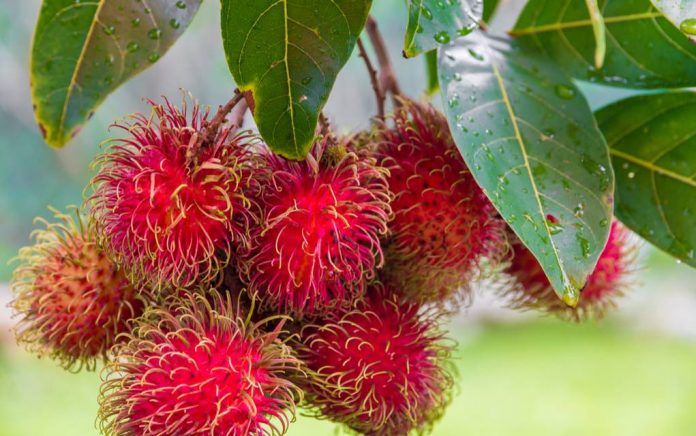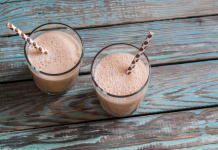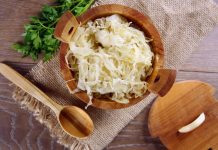
What’s red and green, the size of a golf ball, and looks like it is having a bad hair day? Rambutan fruit! This exotic fruit is native to Indonesia and counts the longan and lychee fruits and its cousins. Once you peel away the unusual looking red and green shell with the hairy spikes, you will find a sweet, creamy white flesh with a seed in the middle.
Although rambutan (Nepheliium lappaceum) may not be a common item in your produce market, it’s worth checking other sources so you can enjoy its many benefits and its sweet/sour taste that has been described as being much like a grape.
Full of nutrients and antioxidants
Each 100 grams (3.5 oz, or about 4 fruits) of ramputan fruit contains up to 2 grams of fiber. Don’t worry—you can get them without eating the hairy spikes! The same amount of fruit provides other nutrients, including 20 percent of your daily need for copper and 2 to 6 percent of your iron, magnesium, manganese, phosphorus, potassium, and zinc.
The vitamin C benefits of rambutan are notable. You can meet half of your daily requirement for vitamin C by eating 5 to 6 rambutan fruit. Along with being a potent antioxidant, the fruit also supports skin health, enhances the absorption of dietary iron, promotes wound healing, and helps with immune function.
Read about 4 weird types of fruit you have to try
Supports healthy digestion
What’s the one thing you always hear mentioned when talking about healthy digestion? Fiber! Rambutan fruit contains both insoluble and soluble fibers. The former type adds bulk to your stool and helps reduce the risk of constipation by helping move food more quickly through the intestinal tract. The latter is nourishment
Could help with weight loss
Research shows that eating fruit is associated with weight loss. Why not add rambutan to the equation! Fruit has several not-so-secret reasons why it helps you with weight loss.
- Typically low in calories. Four rambutan fruit contain about 75 calories.
- Provides natural sweetness. Helps satisfy your sweet tooth with wholesome sugar
- Fills you up. The fiber and water content can make you feel satisfied and reduces your appetite
May help fight infection
The vitamin C in rambutan fruit is its best tool to help the immune system ward off infection. Vitamin C promotes the production of white blood cells, which help fight infections. You may also read about how the compounds in rambutan peel contains substances that can protect against bacteria and viruses. Because there’s not enough evidence concerning the safety of eating the peel, however, this practice is not recommended.
Other health benefits
Both the rambutan fruit and extracts from the peels and seeds have been shown to provide health benefits. For example:
- The phosphorus in rambutan can help with bone health.
- Use of rambutan peel extract has been shown to increase sensitivity to insulin and lower fasting blood sugar levels and insulin resistance in laboratory and animal studies.
- The findings of several lab and animal studies have indicated that rambutan may help prevent the growth and spread of cancer.
- Use of rambutan peel has demonstrated an ability to reduce cholesterol and triglycerides in diabetic mice.
It’s important to note, however, that it is strongly recommended you not eat the peels or seeds of the fruit. More research in humans is needed.
How to eat them
The best way to enjoy the taste and benefits of rambutan fruit is raw. The redder the fruit, the more flavor it will have. You can easily remove the hairy skin by pinching the fruit until the peel splits or cutting the peel with a knife. Discard the peel and eat around the seed. Throw away the seed as well.
Rambutan also can be purchased canned, as a jam, or a juice. The fruit can be put in salads and curries or made into a pudding or ice cream.
Possible risk you need to know
You may read some conflicting stories about whether the peel and seeds of rambutan are safe to eat. Although people in some cultures roast and eat the seeds and also consume the peel, these practices are discouraged. Results of animal research indicates the peel can be toxic and should be avoided. Human studies are needed to verify the safety of eating these part of the rambutan fruit.
The bottom line
If you enjoy trying exotic fruits and want to reap the health benefits they offer, then the rambutan fruit should be on your list. Here’s a simple salad recipe to get you started.
Read This Next: Why Asparagus Makes Your Pee Smell & 8 More Strange Food Side-Effects
Sources
Burton-Freeman B. Dietary fiber and energy regulation. The Journal of Nutrition 2000 Feb; 130(2): 272S-75S
Fang EF, Ng TB. A trypsin inhibitor from rambutan seeds with antitumor, anti-HIV-1 reverse transcriptase, and nitric oxide-inducing properties. Applied Biochemistry & Biotechnology 2015 Apr; 175(8): 3828-39
Ma Q at al. Anti-diabetic effects of phenolic extract from rambutan peels (Nephelium lappaceum) in high-fat diet and streptozotocin-induced diabetic mice. Nutrients 2017 Aug; 9(8): 801
Mercola J. What is rambutan good for? Food Facts 2016 Dec 20
Oregon State University. Phosphorus
Schroder KE. Effects of fruit consumption on body mass index and weight loss in a sample of overweight and obese dieters enrolled in a weight-loss intervention study. Nutrition 2010 Jul-Aug; 26(7-8): 727-34
Soeng S et al. Antioxidant and hypoglycemic activities of extract and fractions of rambutan seeds (Nephelium lappaceum L). Biomedical Engineering 2015; 1(1)
Thinkratok A et al. Safety assessment of hydroethanolic rambutan rind extract: acute and sub-chronic toxicity studies. Indian Journal of Experimental Biology 2014 Oct; 52(10): 989-95
Wall MM. Ascorbic acid and mineral composition of longan (Dimocarpus longan), lychee (Litchi chinensis) and rambutan (Nephelium lappaceum) cultivars grown in Hawaii. Journal of Food Composition and Analysis 2006 Sep-Nov; 19(6-7): 655-63
Yuvakkumar R et al. Rambutan peels promoted biomimetic synthesis of bioinspired zinc oxide nanochains for biomedical applications. Spectrochim Acta A Mol Biomol Spectrosc 2015 Feb 25; 137:250-58










